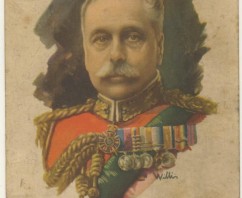The Earl Haig – A Study in Controversy
Field Marshal, the Earl Haig was born in Edinburgh’s Charlotte Square in 1861 and would gain fame and noteriety as the Supreme Commander of the British Forces during the First World War. Haig replaced Sir John French in 1916 as the conflict deteriorated into a war of attrition. At this time, the French were under severe pressure at the Battle of Verdun, so Haig launched the Somme offensive to drive back the German army. The battle lasted a little over 4 months, by which time the casualty figures had exceeded a million. Little gain was made, and Haig and his generals were blamed in many quarters for their ineptitude, and Haig himself became known as the Butcher of the Somme. A year later at the Battle of Passchendaele, huge losses for little success was repeated, but both battles had severely damaged the German army and their resilliance. In November 1918 Haig made the final breakthrough and effectively won the war.
Following the war, Sir Douglas Haig was promoted to the peerage as the Earl Haig; he was then instrumental in setting up the British Legion and the Poppy Appeal – two institutions with the purpose of raising funds and providing help and welfare for soldiers and their families, which is very much the legacy of this most controversial of Scotsmen.






